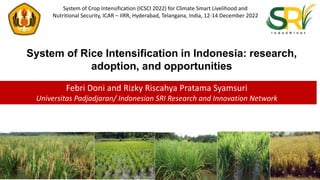
2205 - System of Rice Intensification in Indonesia - Research, Adoption, and Opportunities
- 1. System of Rice Intensification in Indonesia: research, adoption, and opportunities www.ukm.my Febri Doni and Rizky Riscahya Pratama Syamsuri Universitas Padjadjaran/ Indonesian SRI Research and Innovation Network System of Crop Intensification (ICSCI 2022) for Climate Smart Livelihood and Nutritional Security, ICAR – IIRR, Hyderabad, Telangana, India, 12-14 December 2022
- 2. Rice is the most important crop in the world in terms of total developing world production and the number of consumers (2.5 billion) dependent on it as their staple food.
- 3. Rice is the staple food of South East Asia (Including Indonesia) that are associated to specific local customs, folk wisdom, literature and hence belief system. Paddy planting communities play an integral part in the expressions of belief, development and social harmony
- 4. Introduction to rice production STAGNANT INCREASED
- 5. Excessive large scale-agriculture takes away from smallholder (family based) access to land, water and seeds. Land bought over, contaminated water, seeds not own by farmers
- 6. Changing Climate caused the decreased of arable land and thus food production. Man-made or a naturally occurring cyclical events
- 8. We need a new approach
- 9. What is SRI? The System of Rice Intensification (SRI) is a synergistic management methodology for planting and growing rice that involves: • Providing healthier growing conditions for plants by minimizing competition among them through single planting and wider spacing of seedlings • Providing conditions for healthier soil and soil biota by (a) supplying them with organic amendments, (b) aerating the soil as part of weeding, and (c) managing water carefully to avoid both flooding and water stress.
- 10. SRI vs. Conventional methods SRI Methods Mostly aerobic unsaturated soil Organic matter as fertilizer for soil enhancement Mechanical weeding, IPM and soil aeration Conventional Methods Continuous flooding Use of chemical fertilizer Herbicide use
- 11. SRI vs. Conventional methods SRI Non-SRI SRI Non-SRI SRI Non-SRI Lodging from storm damage Darker green color, more chloro- phyll and more photosynthesis
- 12. SRI Conventional SRI Conventional Conventional SRI SRI Methods enhance rice agronomic and physiological potency
- 13. Previous research on how SRI method increases rice growth and yield focuses on G x E
- 14. SRI in Indonesia
- 15. The Spread of SRI in Indonesia • SRI was introduced in 1997 to Ministry of Agriculture, Indonesia by Prof. Norman Uphoff. • Encouraged by Prof. Uphoff presentation, Indonesian Agency for Agricultural Research and Development started to evaluate SRI in Indonesia.
- 16. SRI evaluations were started by the Indonesian Agency for Agricultural Research and Development (IAARD) in 1999 at its rice research station at Sukamandi, with a yield of 6.2 t/ha the first season, and up to 9 t/ha in the next season.
- 17. The Indonesian IPM program began evaluating SRI in 2000. Farmer Field School participants in Ciamis evaluated SRI methods in 2001 and got a 52% increase in yield. A series of four workshops held in January 2003 with Farmer Field School participants across Java found that SRI methods were averaging 9.25 t/ha.
- 18. Several International NGOs Begin Promoting SRI Methods in 2002 Adventist Development and Relief Agency (ADRA), a major international NGO working in West Timor with USAID funding. Farmer SRI plots averaged 11.7 t/ha compared to the conventional comparison yield of 4.4 t/ha.
- 19. From 2005 to 2006, SRI promotion was centred in Java and Eastern Indonesia
- 20. Presiding at an 'SRI Harvest Festival' in Cianjur district, West Java, on July 30, 2007. President Susilo Bambang Yudhoyono made a strong statement of support for the spread of SRI within Indonesia and even the world, citing concerns about environmental quality and climate change as well as meeting the food requirements of a still-growing population.
- 22. SRI spread in Morowali, South Sulawesi
- 23. >100,000 ha rice fields are converted into SRI in Morowali
- 24. SRI is spread across Indonesia
- 25. SRI is adopted by million of farmers in Indonesia
- 26. SRI research in Indonesia
- 27. 0 10 20 30 40 50 60 2006 2007 2008 2009 2010 2011 2012 2013 2014 2015 2016 2017 2018 2019 2020 2021 2022 Number articles by year SRI research items published by Indonesian researchers
- 28. 0% 5% 10% 15% 20% Water Management Weed Management Nutrient Management Soil Biota Adoption Review Economi Evaluation Plant Density Policy Variety Trial Climate Change Mitigation SRI main research topics
- 29. 94 258 Journal Indexing Scopus Non-Scopus SRI published items indexed by Scopus Need improvement in term of QUALITY
- 30. What’s next?
- 31. Challenges While the numerous trainings and meetings by NGO’s and individuals have helped SRI to spread in Indonesia, it demands stronger understanding and support from the government sector. Problems Face by SRI farmers: • Rice policies which always change • Inadequate infrastructure – economic and administrative • Post-harvest and market challenges facing small-scale rice farmers remain the main obstruction to SRI spread. • The main obstacle is to get farmers to unlearn conventional rice farming and to appreciate SRI approaches that has proven productivity records.
- 32. Our Efforts IndoSRInet: Indonesian SRI Research and Innovation Network
